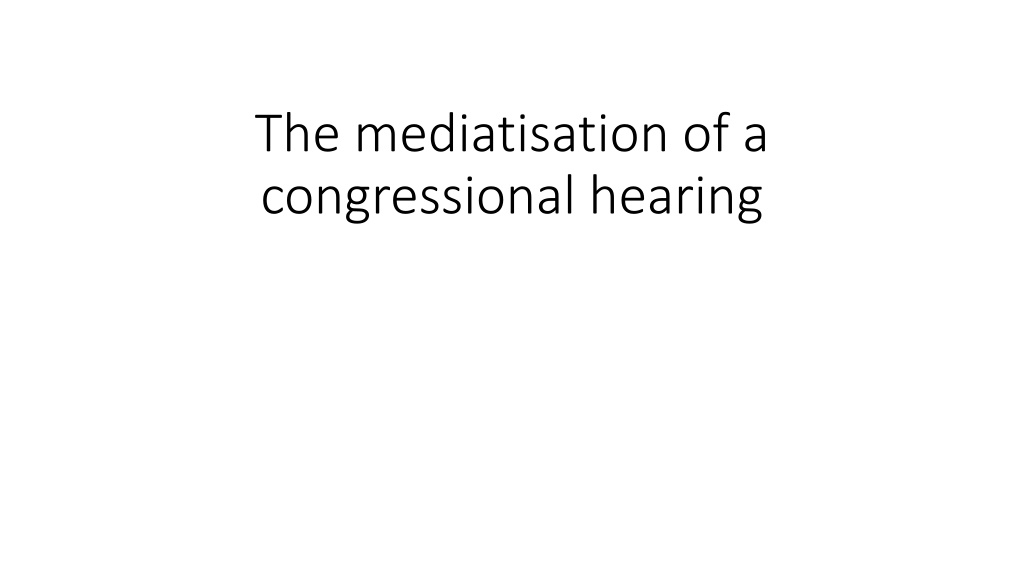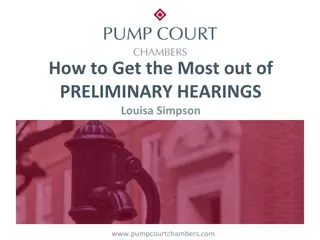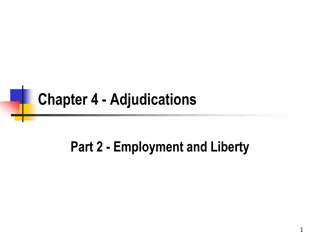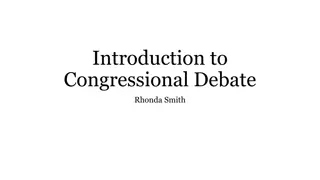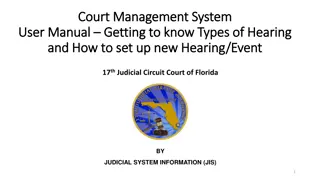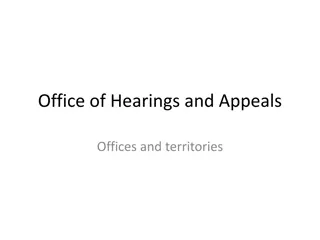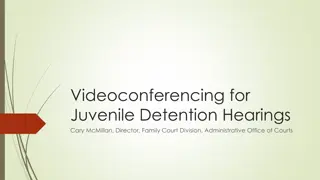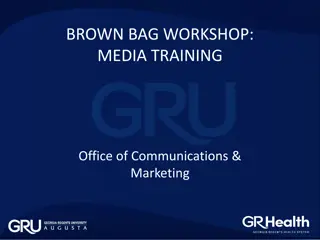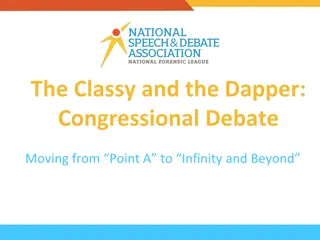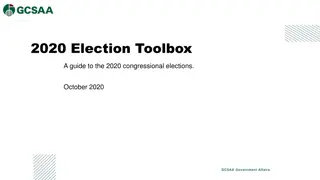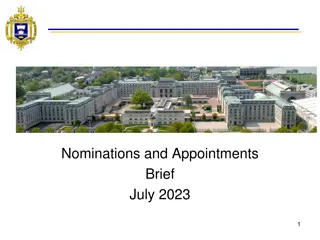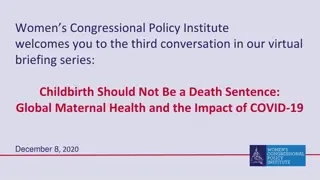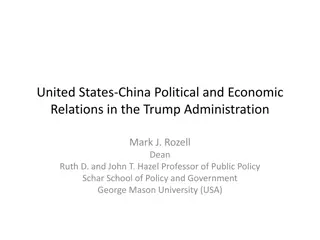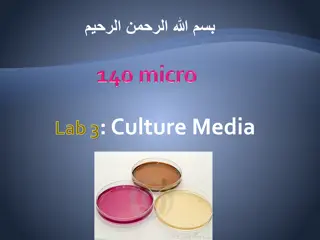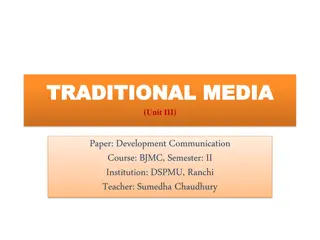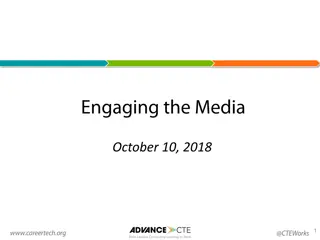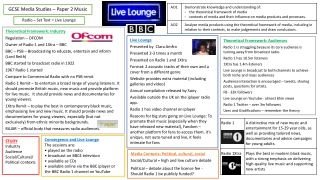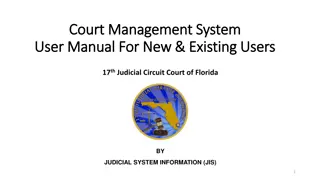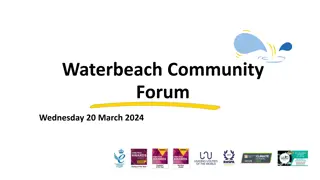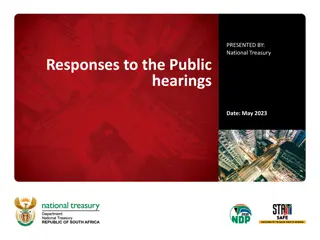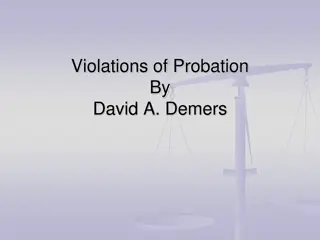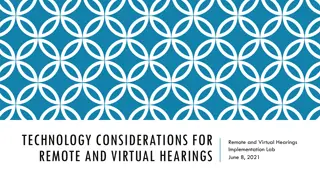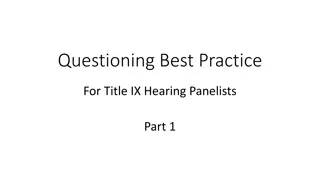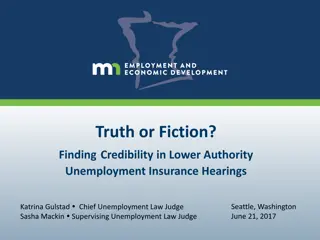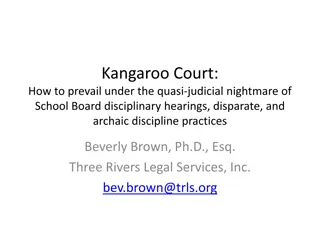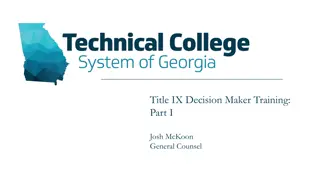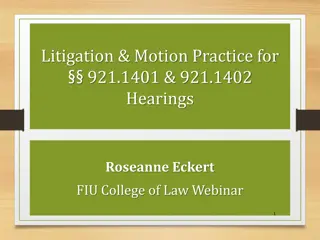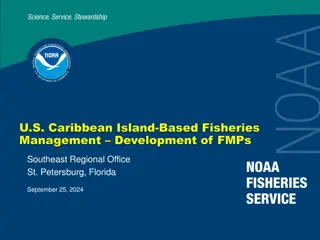The Mediatisation of Congressional Hearings: a Media Analysis
An exploration of how congressional hearings, particularly those involving the Clintons, transition into media coverage, highlighting the adoption of textual constructions and discursive strategies by the press. The study delves into the producer's perspective, emphasizing the influence of audience participation in media language. Additionally, it discusses the ideological significance of journalistic storytelling and challenges the notion of objectivity in contemporary journalism.
- Media Analysis
- Congressional Hearings
- Press Coverage
- Journalism Perspective
- Ideological Significance
Download Presentation

Please find below an Image/Link to download the presentation.
The content on the website is provided AS IS for your information and personal use only. It may not be sold, licensed, or shared on other websites without obtaining consent from the author. Download presentation by click this link. If you encounter any issues during the download, it is possible that the publisher has removed the file from their server.
E N D
Presentation Transcript
The mediatisation of a congressional hearing
Clintons hearing migrates to the press the extent to which CGHR s textual and discursive constructions are adopted wholly or partially by the press the way in which journalists use congressional hearings material strategies deployed to incorporate the hearing either to endorse or criticise Clinton s version of the events
Clintons hearing migrates to the press The production perspective though linguistic research has usually been limited to the close analysis of news products, thus overlooking news producers perspective The materiality of texts is at the centre of the investigation, without giving in to the temptation of seeing language as a transparent medium reporting journalists real thought The audience, despite its apparent passivity, is an influential participant in media language, as news producers have a target audience in mind when they write. The analysis of the reception process audience (not included) as one of the stakeholders in news discourse
Jacobs, Maat and van Hout argue that : as cultural brokers disseminating world knowledge, the stories journalists tell are ideologically significant. This observation is old news, but ever so timely, especially given today s mediascape of convergence, innovation, competition, and globalization (2008, p. 1) Actors who are involved in the media process generally convey ideological distinctions and differing representations aimed to address an ideal audience that will/will not be comfortable with the offered ideological position.
Objectivity On one hand, journalistic institutions assert the objectivity of their discourse and maintain that journalistic texts are factual , impartial , balanced and free of any of the journalistic author s own opinions and perspectives. On the other hand, the journalist as a disinterested transmitter of the news is a figure who is no longer on the stage of contemporary journalism, if ever he or she was. nowadays objectivity seems to be merely pretended and journalist discourse is very frequently and openly value-laden
Objectivity degree of objectivity may be related to the kind of newspaper (i.e. tabloid, broadsheet) the journalist works for news articles, which in theory are supposed to report events faithfully, actually often tend to be manipulative. The distinction between news and comment, once a cornerstone of the broadsheet newspapers, is fading and information is often interwoven with commentary. This fact is expected in editorials where their typical argumentative structure caters to a declared purpose of setting forth opinions rather than reporting facts and induce the reader to construct a preferred model of the event being discussed while it is less expected if we consider news articles.
Journalism as an interpretative practice Peterson s view of journalism as an interpretative practice news production is a process of entextualisation, i.e. the extraction (decontextualisation) of source materials and its subsequent insertion (recontextualisation) into a (new) news discourse (van Hout and Jacobs 2008) Goffman (1981): embedding (i.e. the incorporation of one speech event into another): most of the news reported in news articles actually consists of previously composed text reworked into text news (Bell 1991, p. 41).
the need for fast news production increases and deadlines tighten It is a technologically contingent process Clinton testified on Capitol Hill on 23 January 2013, first in front of the Senate Foreign Relations Committee, and in front of the House Foreign Affairs Committee the afternoon of the same day. The selected articles for the present analysis were issued within the following day
Clintons hearing AIM: to investigate the extent to and the manner in which Clinton s 2013 hearing was used by news media when reporting on the case. newsarticle (no weekly publications more focused on commentary, as it usually comments on facts that have already been extensively reported by the media) The New York Times: reaches up to a million readers daily, long- established tradition manually tagged to identify the presence of Clinton s hearing in the texts
RQs RQ 1. In reporting about Clinton s hearing, to what extent does the newspaper under consideration make use of the hearing textual data? RQ 2. When the hearing is incorporated into the news pieces, what kind of operations are carried out on its text?
Theoretical model Catenaccio s model (2008) developed drawing on van Dijk and Bell: 1) Selection 2) Reproduction 3) Summarization 4) Restyling 5) Stance
Theoretical model Selection implies selecting parts of the congressional hearing to be used in news articles and detecting a possible pattern of inclusion/exclusion Reproduction refers to the parts of the hearing that are incorporated into the news articles with no changes Summarisation is the information provided in the hearing that is summarised in news articles Restyling implies rearranging the information that was provided in the hearing Stance is the (possibly present) evaluation towards the information that is provided in the hearing.
the final, official, congressional hearings are published after a few months, and usually no later than two years. final documents include additional materials submitted for the record, such as the written responses from witnesses to questions presented by committee members, which typically occupy many pages Clinton s hearing at the Senate which the hearing journalists are more likely to refer to, as it was the first to be delivered the final, official document consists of seventy pages. a significant part of it could not have been used by journalists covering the event that day, in particular the above-mentioned additional materials, which were included after the hearing took place and are made up by Secretary of State s responses to questions submitted by six senators. In fact, the material that journalists could use the same day consist of the transcription of the question-and-answer section of the hearing and, more interestingly, the prepared opening statement, which is often distributed to media representatives
Witness opening statement the witness s opening statement plays a major role both in quantitative terms (number of lines where her words from this part of the hearing are reported, quoted, and/or summarised), and in qualitative terms (lines from the opening statement frequently occupy salient positions).
The New York Times: selection Clinton s hearing (about 70 pages): its embedding in a news article necessarily implies a major process of selection, which results in only a few lines of the document being actually used in the final news piece relatively numerous lines of the article corresponding to roughly 10% of the text come from a really small part of the congressional document, i.e. the witness opening statement. prominent position (in the second, fourth and most notably last paragraph of the news article): confirms the crucial role the statement plays in the event this idea is also reinforced by the information provided by the expert informant, who explained that the opening statement is distributed by congressional committees to media representatives covering the event the very day it takes place, thus providing journalists with ready-to-use material.
The other part of the hearing that is selected and partially reproduced in the news article is the verbal question-and-answer session between committee members and the witness In Clinton s hearing, this is the longest part of the document and it counts for slightly more than 50% of the text (pages from 11 to 48). The remaining parts, which are not embedded in the news article at all, are the short opening statements by two committee members (from page 1 to 6) and the written responses of the Secretary of State to questions submitted by six senators. This is a rather long part (from page 49 to 70), which corresponds to 30% of the text and is submitted after the conclusion of the actual hearing, as it is quite common in the U.S. Congress for committees to obtain information from a witness both before and after the hearing in which the witness appears in person.
The New York Times: reproduction Reproduction: data suggest that the information provided in the news article heavily relies on the input source. In fact, 60% of the news article is made up by actual words from the hearing, both in the form of direct and indirect speech. The latter slightly prevails (18 vs. 14 lines) and it is also the journalist s choice for the second paragraph, the first where Clinton s words are reproduced verbatim: As I have said many times, I take responsibility, and nobody is more committed to getting this right, she said, reading a statement during a day of testimony before Senate and House committees. I am determined to leave the State Department and our country safer, stronger and more secure.
The New York Times: summarization Due to the different size of the two texts the congressional hearing and the news article the strategy of summarisation was expected, with different parts of the hearing being conflated into one single sentence in the resulting text. Summarization is a distinctive strategy in about 30% of paragraphs, including the very first one: But Mrs. Clinton, whose appearance before Congress had been postponed since December because of illness, quickly departed from the script. She jousted with Republican lawmakers over who deserved blame for the security problems at the compound, and choked up as she described being at Joint Base Andrews outside Washington when the bodies of the Americans killed in the assault arrived from Libya.
The New York Times: restyling The fourth process at work in the news article is restyling, and it consists in reporting the information provided in the hearing in a different order. The clearest example of this process can be found in the penultimate paragraph of the news article, where Clinton s words from her opening statement which instead occupies the initial pages of the congressional document close the article (the very last line being a single-line quotation form the question-and- answer session), as they also opened it: Benghazi didn t happen in a vacuum, she said. The Arab revolutions have scrambled power dynamics and shattered security forces across the region. And instability in Mali has created an expanding safe haven for terrorists who look to extend their influence and plot further attacks of the kind we saw just last week in Algeria. We are in for a struggle, but it is a necessary struggle, she said. We cannot permit northern Mali to become a safe haven.
The New York Timess massive use of reproduction processes is deemed to also be significant in evaluating the newspaper s stance towards the information that is provided in the congressional hearing. In epistemic terms, Clinton s and the committee members words openly represent their points of view and, accordingly, they are attributed either when quoting verbatim or through indirect speech. Commentary can therefore be located only in the remaining (small) part of the text: The continuing controversy over the attack, which resulted in the deaths of Ambassador J. Christopher Stevens and three other Americans, has cast a cloud over Mrs. Clinton s final months at the State Department. It also has enormous political implications for Mrs. Clinton, the former New York senator who is already regarded as the front-runner for the 2016 Democratic presidential nomination if she chooses to run. It was the first time she had faced extensive questioning about her role in the episode
In The New York Times, the commentary parts generally maintain a neutral tone and are sometimes compounded with direct and indirect speech, as example 6 exemplifies: One of the sharpest exchanges of the day came when Mrs. Clinton responded to questions from Senator Ron Johnson, a Wisconsin Republican, by saying there was too much focus on how the Benghazi attack had been characterized in its early hours and not enough on how to prevent a recurrence. Republicans have repeatedly charged that Obama administration officials deliberately played down the attack, focusing much of their criticism on Susan E. Rice, the ambassador to the United Nations and once Mr. Obama s choice to succeed Mrs. Clinton.
The paragraph which follows deserves a few words. In fact, the neutral tone of the preceding commentary paragraph leaves space to an extremely vivid and frequently quoted citation from the hearing, as a cursory reading of other newspapers issued the same day revealed: Was it because of a protest, or was it because of guys out for a walk one night who decided they d go kill some Americans? What difference, at this point, does it make? Mrs. Clinton said, her voice rising. It is our job to figure out what happened and do everything we can to prevent it from ever happening again, Senator.
In The New York Times pages, a combative Hillary, who vigorously defended her handling of the attacks, jousted with Republican lawmakers over who deserved blame for the security problems in Benghazi and face[s] extensive questioning about her role in the episode, is portrayed Her voice is mixed with the voices of her opponents, coming both from direct and indirect speech, thereby presenting the reader with a multi- perspective picture of the situation: Mr. McCain asserted that the Obama administration s aversion to nation- building had precluded it from providing the kind of training and assistance that would have helped the fledgling Libyan government in Tripoli confront growing security threats from militants. We did not give them the kind of assistance that would have been necessary to help dismantle these militias that still, to this day, remain a challenge to democracy in Libya, he said.
Conclusions the strategy that mostly reveals an evaluative treatment of the material from the hearing seems to be restyling rhrough restyling, a small part of the congressional document a part which for its very nature presents the witness s point of view is given prominence in the news article However, The New York Times notwithstanding its publicly declared support for the Democrat party during the presidential elections both in 2008 and 2012 seems careful in presenting the event in the most neutral way in the article under investigation: the commentary parts sound impartial, and the reproduced parts relay both Clinton s and her opponents words The Grey Lady, as The New York Times is nicknamed, has gained a national and international reputation, and its neutral stance was expected also in the case of a highly controversial topic like Clinton s handling of the Benghazi crisis.
Conclusions Although the hearing is extensively (roughly 85% of the article) relied on, and never combined with data from other sources, and even if the reproduction process features comparatively often in the article, with a relative prominence of the witness opening statement, the two newspapers can hardly be said to reproduce Clinton s versions of the events however, the fact that the witness opening statement is overrepresented both quantitatively and qualitatively in the news piece may suggest a different attitude: for its very nature, the witness opening statement contains a favourable self-representation of the witness lack of explicit commentary seems to be primarily linked to the identity being construed by these prestigious paper, whose objectivity and impartiality are crucial for its reputation as trustworthy imparter of information
